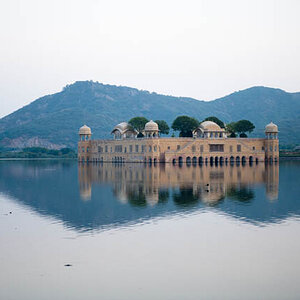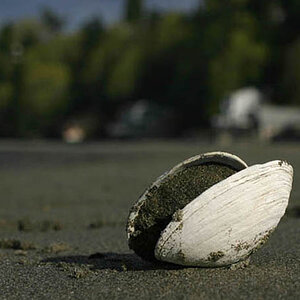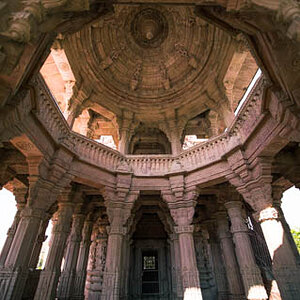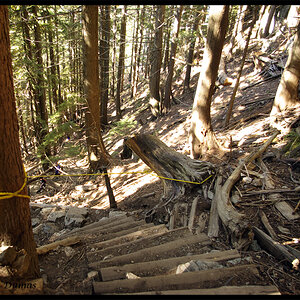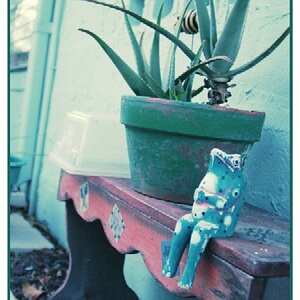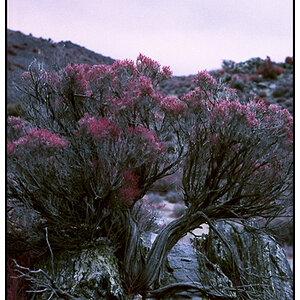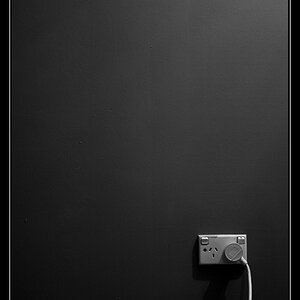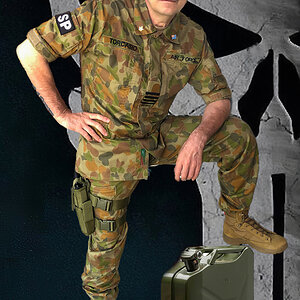Lincostudio
TPF Noob!
- Joined
- Mar 23, 2010
- Messages
- 2
- Reaction score
- 0
Portraiture truly is a sweet science of light. For years I have stuck exclusively close to my strobes ?totally rejecting hot lights (and absolutely any other continuous light source for that matter) as kidish, under-powered or just plain impractical. Today is a different story as I have become an instant convert to continuous lighting! Hold your horses there?I didnt say hot lights though! Im talking about the low cost, high output of Britek Daylight Balanced Flourescent Continuous Lights!
Let me walk you through my first time ever out with these hidden jewels of the industry. Since I am know at Studiolighting.net as The Prince of Cheap,?my goal was to shoot assuming I had minimal gear. Just a basic DSLR, kit lens (F5.6 would be the widest aperture I could use), a fastest shutter speed of 1/125th, with the highest ISO I could use being 400.
Having such a strict set of rules could nearly guarantee if I were a beginner I should be able to get good results from the lighting. Also, I limited myself to a maximum of only 2 lights for this test ?this way If I were on a strict budget only having 2 lights would probably reflect that. The kit consisted of a large bank (a single housing that holds multiple lights that are individually controlled) 40 x 40 inch softbox, large heavy duty lights stand and a 4 bulbs. The secondary light consisted of a single light head, a single bulb and a parabolic reflector as well as an optional 24 x 24 inch softbox. My only other option would be my trusty ebay 5n1 reflector kit with stand.
 word on Continuous Light: Continuous light is in essence an always on source? What you see is what you get. Traditionally continuous light sources are bright, lights from Tungsten or Halogen sources?hot and very uncomfortable for models and fire hazards themselves. Daylight Balanced Flourescent lights on the other hand remain relatively cool and have even been color corrected to mimic the same color output as electronic flash! Because of this, many beginners dont believe in light meters because of the digital age of the shoot n chimp?(take an image and adjust purely based on your cameras LCD), while I get caught in this myself, I however will always start off very close by metering my situation with a light meter first. Also, remember, because of a digital sensors low dynamic range (ability to record both very bright and very dark areas in an image at once) its ever more important now than ever to have a light meter! Im sure Will Crocket would agree. My suggestion?get a light meter that reads ambient light as both incident (it striking an area) and reflective (it reflecting off of an area)!
word on Continuous Light: Continuous light is in essence an always on source? What you see is what you get. Traditionally continuous light sources are bright, lights from Tungsten or Halogen sources?hot and very uncomfortable for models and fire hazards themselves. Daylight Balanced Flourescent lights on the other hand remain relatively cool and have even been color corrected to mimic the same color output as electronic flash! Because of this, many beginners dont believe in light meters because of the digital age of the shoot n chimp?(take an image and adjust purely based on your cameras LCD), while I get caught in this myself, I however will always start off very close by metering my situation with a light meter first. Also, remember, because of a digital sensors low dynamic range (ability to record both very bright and very dark areas in an image at once) its ever more important now than ever to have a light meter! Im sure Will Crocket would agree. My suggestion?get a light meter that reads ambient light as both incident (it striking an area) and reflective (it reflecting off of an area)!
When I setup my lights I already guessed I would have to use ISO 400, F5.6 @ 1/30th of a second (meaning I expected a very low output of light) as a couple of continuous light users have reported in the past to me with other kits. But since this was a single person, 2/3rd body shot where I wanted ultra soft light and a low key background I placed the main light about 4ft from the subject with the light from the softbox only skiming across the subject. To my overwhelming surprise, my meter read a correct exposure of F5.6, 1/60th at ISO 100! That meant that my initial thought was about 3 fstops under what the lights could produce! Awesome!
This means that this single light bank WILL grant even a newbie enough power to light like a pro! After I figured my exposure it was time to shoot away. I set my white balance to auto for some and manually set it to 5600k (to make sure the light wouldnt have a greenish-tinge) but found that the auto white balance of my DSLR did a much better job than I had! Shot after shot I have perfect exposures of ULTRA SOFT FINE LIGHT!!! Once I realized that I had never created light so soft I realized that I had just been converted to a fluorescent light lover of the highest order! 275 images later I realized that this was FAR easier than working with my strobes! You dont have to wait for them to recycle, no wondering if they went off from the remote trigger, if the optical slave saw the flash if the subject blinked?NOTHING! What you see is just what you get!
 you can see the Light quality of the Birtek Flourescent Continuous light System Pro 5000 produces exquisite and absolutely beautiful light for portraits. The amazing thing is that with the amount of power generated wouldve allowed me to go up to F8 without killing myself (image quality wise) at ISO 800! An amazing feat for continuous lights! Okay, heres the way I see it. With Flourescent lights inherent ability to remain relatively cool (even within inches of my subject) makes it an attractive alternative (yes I said ALTERNATIVE) to flash if you are starting out. The soft light of this kit is perfect for engagements sessions, portraits, senior sessions and any other in-studio session where everyone can just walk up and let there cameras program mode steal a great shot from the paid photographer (thats where strobe has its advantage?the photographer is the only one with control over the lights on location with a wireless triggering system that is).
you can see the Light quality of the Birtek Flourescent Continuous light System Pro 5000 produces exquisite and absolutely beautiful light for portraits. The amazing thing is that with the amount of power generated wouldve allowed me to go up to F8 without killing myself (image quality wise) at ISO 800! An amazing feat for continuous lights! Okay, heres the way I see it. With Flourescent lights inherent ability to remain relatively cool (even within inches of my subject) makes it an attractive alternative (yes I said ALTERNATIVE) to flash if you are starting out. The soft light of this kit is perfect for engagements sessions, portraits, senior sessions and any other in-studio session where everyone can just walk up and let there cameras program mode steal a great shot from the paid photographer (thats where strobe has its advantage?the photographer is the only one with control over the lights on location with a wireless triggering system that is).
Overall, what does this mean, it means that I can setup a quickie shoot for 30 minutes in-studio with a background change nail it and move on to outdoor romantic portraits that theyll just die over collect the check and have a happy day! Get ready for a few more converts?Britek has just helped open up a whole new chapter with these?slick-n-cool-lights? I suspect that if Britek continues to provide low cost lighting to the masses of this quality, theyre going to make a ton of money and wont have enough bank accounts to hold it!
Let me walk you through my first time ever out with these hidden jewels of the industry. Since I am know at Studiolighting.net as The Prince of Cheap,?my goal was to shoot assuming I had minimal gear. Just a basic DSLR, kit lens (F5.6 would be the widest aperture I could use), a fastest shutter speed of 1/125th, with the highest ISO I could use being 400.
Having such a strict set of rules could nearly guarantee if I were a beginner I should be able to get good results from the lighting. Also, I limited myself to a maximum of only 2 lights for this test ?this way If I were on a strict budget only having 2 lights would probably reflect that. The kit consisted of a large bank (a single housing that holds multiple lights that are individually controlled) 40 x 40 inch softbox, large heavy duty lights stand and a 4 bulbs. The secondary light consisted of a single light head, a single bulb and a parabolic reflector as well as an optional 24 x 24 inch softbox. My only other option would be my trusty ebay 5n1 reflector kit with stand.

When I setup my lights I already guessed I would have to use ISO 400, F5.6 @ 1/30th of a second (meaning I expected a very low output of light) as a couple of continuous light users have reported in the past to me with other kits. But since this was a single person, 2/3rd body shot where I wanted ultra soft light and a low key background I placed the main light about 4ft from the subject with the light from the softbox only skiming across the subject. To my overwhelming surprise, my meter read a correct exposure of F5.6, 1/60th at ISO 100! That meant that my initial thought was about 3 fstops under what the lights could produce! Awesome!
This means that this single light bank WILL grant even a newbie enough power to light like a pro! After I figured my exposure it was time to shoot away. I set my white balance to auto for some and manually set it to 5600k (to make sure the light wouldnt have a greenish-tinge) but found that the auto white balance of my DSLR did a much better job than I had! Shot after shot I have perfect exposures of ULTRA SOFT FINE LIGHT!!! Once I realized that I had never created light so soft I realized that I had just been converted to a fluorescent light lover of the highest order! 275 images later I realized that this was FAR easier than working with my strobes! You dont have to wait for them to recycle, no wondering if they went off from the remote trigger, if the optical slave saw the flash if the subject blinked?NOTHING! What you see is just what you get!

Overall, what does this mean, it means that I can setup a quickie shoot for 30 minutes in-studio with a background change nail it and move on to outdoor romantic portraits that theyll just die over collect the check and have a happy day! Get ready for a few more converts?Britek has just helped open up a whole new chapter with these?slick-n-cool-lights? I suspect that if Britek continues to provide low cost lighting to the masses of this quality, theyre going to make a ton of money and wont have enough bank accounts to hold it!


